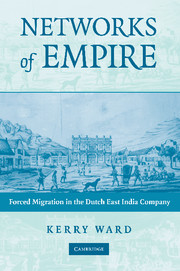Book contents
- Frontmatter
- Contents
- List of Maps
- Acknowledgments
- 1 Networks of Empire and Imperial Sovereignty
- 2 The Evolution of Governance and Forced Migration
- 3 Crime and Punishment in Batavia, circa 1730 to 1750
- 4 The Cape Cauldron: Strategic Site in Transoceanic Imperial Networks
- 5 Company and Court Politics in Java: Islam and Exile at the Cape
- 6 Forced Migration and Cape Colonial Society
- 7 Disintegrating Imperial Networks
- Bibliography
- Index
- VOC Shipping Networks
- References
3 - Crime and Punishment in Batavia, circa 1730 to 1750
Published online by Cambridge University Press: 30 July 2009
- Frontmatter
- Contents
- List of Maps
- Acknowledgments
- 1 Networks of Empire and Imperial Sovereignty
- 2 The Evolution of Governance and Forced Migration
- 3 Crime and Punishment in Batavia, circa 1730 to 1750
- 4 The Cape Cauldron: Strategic Site in Transoceanic Imperial Networks
- 5 Company and Court Politics in Java: Islam and Exile at the Cape
- 6 Forced Migration and Cape Colonial Society
- 7 Disintegrating Imperial Networks
- Bibliography
- Index
- VOC Shipping Networks
- References
Summary
Batavia grew into the capital of the Dutch East India Company through the evolution of its legal, administrative, political, transportation, and communication networks that provided the template for the evolution of other nodes in the empire. Located on the eastern coast of Java, Batavia was, from 1619, the seat of the Company's High Government at the center of power, though it was by no means omnipotent in its control over the imperial web. The Company's aim was to make Batavia the major entrepôt on the Straits of Malacca, filtering trade from the Indian Ocean and South China Sea. By 1730, the inner city population of Batavia was nearly 24,000 and the Company had invested massive amounts of money and labor to stimulate its growth. The Company's network of forced migration facilitated slave labor in Batavia and throughout the empire through the slave trade; it used penal transportation and political exile to bolster the rule of law by banishing criminals and political opponents from Batavia to other Company nodes, including the Cape of Good Hope.
This chapter examines the institutions of law and governance in Batavia through the criminal record of the Council of Justice that produced convicts for potential banishment. It focuses particularly on the period before and after the massacre of Batavia's Chinese population in 1740 to demonstrate both the Company's efforts and its failures to enforce the rule of law.
- Type
- Chapter
- Information
- Networks of EmpireForced Migration in the Dutch East India Company, pp. 85 - 126Publisher: Cambridge University PressPrint publication year: 2008

